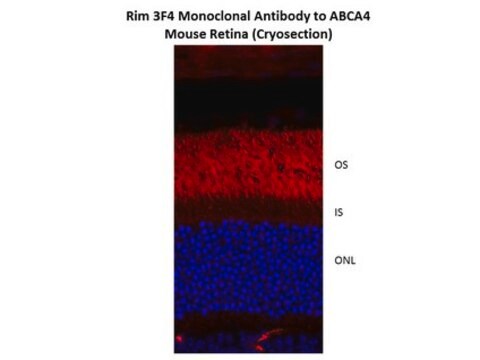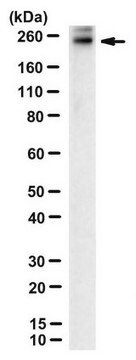MABN1775
Anti-ABCA4 Antibody, clone TMR1
clone TMR1, from mouse
Synonim(y):
Retinal-specific ATP-binding cassette transporter, ATP-binding cassette sub-family A member 4, RIM ABC transporter, RIM protein, RmP, Stargardt disease protein
About This Item
Polecane produkty
pochodzenie biologiczne
mouse
Poziom jakości
forma przeciwciała
purified antibody
rodzaj przeciwciała
primary antibodies
klon
TMR1, monoclonal
reaktywność gatunkowa
human, mouse
reaktywność gatunkowa (przewidywana na podstawie homologii)
bovine (based on 100% sequence homology)
metody
immunocytochemistry: suitable
immunofluorescence: suitable
western blot: suitable
izotyp
IgG1κ
numer dostępu NCBI
numer dostępu UniProt
Warunki transportu
wet ice
docelowa modyfikacja potranslacyjna
unmodified
informacje o genach
human ... ABCA4(24)
Opis ogólny
Ref.: Tsybovsky, Y et al. (2010). Adv. Exp. Med. Biol. 703, 105-125.
Specyficzność
Immunogen
Zastosowanie
Immunocytochemistry Analysis: A representative lot detected similar cellular localization of wild-type and ABCA4 missense constructs with either or both L541P and A1038V mutation by fluorescent immunocytochemistry staining of 4% paraformaldehyde-fixed, 0.1% Triton X-100-permeabilized HEK293 transfectants (Zhang, N., et al. (2015). Hum. Mol. Genet. 24(11):3220-3237).
Immunofluorescence Analysis: A representative lot detected ABCA4 immunoreactivity in retina cryosections from wild-type mice and mice with heterozygous L541P;A1038V (PV) missense mutaion, but not mice with homozygous PV mutation (Zhang, N., et al. (2015). Hum. Mol. Genet. 24(11):3220-3237).
Neuroscience
Jakość
Western Blotting Analysis: A 1:125 dilution of this antibody detected ABCA4 in 10 µg of human retina tissue lysate.
Opis wartości docelowych
Postać fizyczna
Przechowywanie i stabilność
Inne uwagi
Oświadczenie o zrzeczeniu się odpowiedzialności
Nie możesz znaleźć właściwego produktu?
Wypróbuj nasz Narzędzie selektora produktów.
Kod klasy składowania
12 - Non Combustible Liquids
Klasa zagrożenia wodnego (WGK)
WGK 1
Certyfikaty analizy (CoA)
Poszukaj Certyfikaty analizy (CoA), wpisując numer partii/serii produktów. Numery serii i partii można znaleźć na etykiecie produktu po słowach „seria” lub „partia”.
Masz już ten produkt?
Dokumenty związane z niedawno zakupionymi produktami zostały zamieszczone w Bibliotece dokumentów.
Nasz zespół naukowców ma doświadczenie we wszystkich obszarach badań, w tym w naukach przyrodniczych, materiałoznawstwie, syntezie chemicznej, chromatografii, analityce i wielu innych dziedzinach.
Skontaktuj się z zespołem ds. pomocy technicznej








